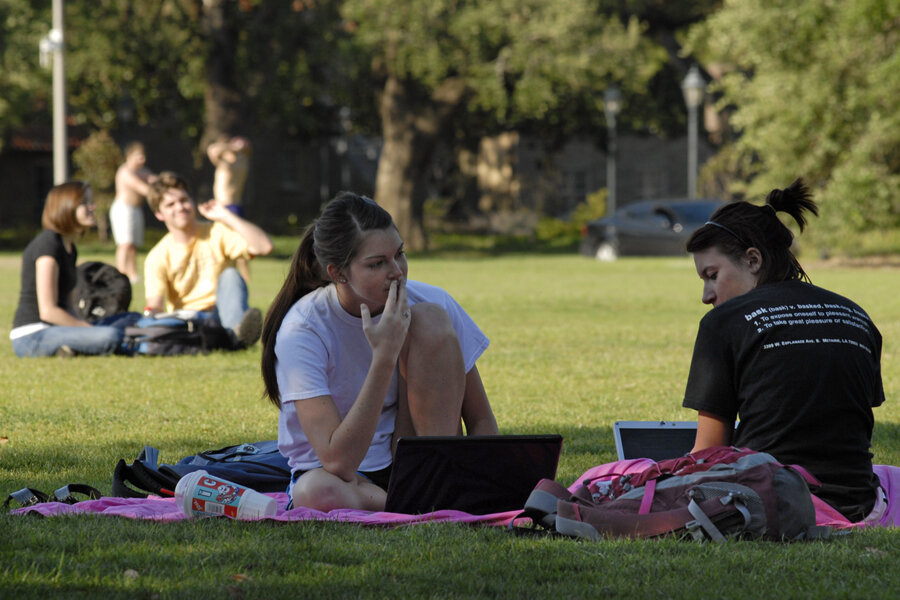State college tuition skyrocketed during recession, study finds
Loading...
As state budgets bounce back from the Great Recession, most are starting to increase their funding of higher education, an area of spending where cuts went especially deep. But all but two states – Alaska and North Dakota – still spend less per student than they did before the recession.
With both college tuition and student loans skyrocketing in recent years, much attention has gone to those state funding levels – a major reason behind the spiraling cost of attending college, at least for public institutions. A new report from the Center for Budget and Policy Priorities (CBPP), a Washington think tank, quantifies just how much funding for public colleges and universities was cut in the past six years, and what the effects of those cuts have been.
“In many states the cuts have been extraordinarily deep,” said Michael Mitchell, an author of the report, in a call with reporters. “Over the last 25 years, nearly every state has shifted higher education costs from the state to students – this has been a trend for some time. But the recession, and the years following the recession, absolutely kicked this trend into high gear…. The cuts are in part a result of state revenue collapse, but they were also a product of poor policy choices, with states relying on spending cuts to make up for lost revenue.”
The cuts vary widely by state. In 37 states, per-pupil spending, adjusted for inflation, is now more than 20 percent lower than in 2008. Arizona, Louisiana, and South Carolina have reduced per-pupil spending by more than 40 percent.
Over the past year, the spending trends have slowly started to reverse. Forty-two states are spending more per pupil than they did a year ago – an increase of $449 per pupil, or 7.2 percent on average, among states that increased their funding. But eight states reduced higher education funding still more in the past year, with particularly deep cuts in Wyoming, West Virginia, Louisiana, Wisconsin, and North Carolina.
Getting states to bring spending back to pre-recession levels, even though their budgets have recovered, can be a daunting challenge.
“When times are bad, states increase tuition. When times are good, you don’t see them lowering tuition,” says Amy Laitinen, deputy director for higher education at the New America Foundation. “Over the past few decades, we’ve really seen a breakdown of states’ commitment to higher education. We see the federal government and students and families picking up increasing shares of the tab. That trend is not going away.”
Ms. Laitinen notes that it’s easy for state legislatures to choose to slash higher education funding when charged with balancing budgets and faced with the choice of cutting higher education versus money for health care or prisons or K-12 education.
“There’s no alternative revenue for health care or prisons, but you can charge students more tuition,” she says. “But these are choices that the legislature makes; none of this has to be done. All of these budgetary decisions are decisions about priorities, and clearly affordable education, in which the state picks up a larger share of the tab, is not at the top of every state’s priority list.”
While tuition has also skyrocketed at private and for-profit colleges, for different reasons, state funding has been the biggest driver of tuition increases at public institutions.
In the past year, as the economy has adjusted, the levels of tuition increase for public colleges has eased off a bit.
The CBPP study found that just seven states – Louisiana, Colorado, Connecticut, Hawaii, Kansas, Virginia, and Mississippi – raised tuition by more than $300 from the 2012-13 year, adjusting for inflation. In 12 states, tuition actually fell slightly. “It’s a good sign that states are reinvesting again,” says Mr. Mitchell.
But since 2008, the rises in tuition have been steep. The average tuition for four-year public institutions has risen by more than 60 percent in six states, more than 40 percent in 10 states, and more than 20 percent in 29 states. In Arizona, where tuition has risen the most, tuition has jumped more than 80 percent – $4,493 per student, after inflation – since 2008.
Such tuition increases, says Mitchell, have a big impact on enrollment and the type of college a student picks, particularly for low-income and minority students – and down the road, can have an impact on lifetime earning power for those students.
Today, he notes, tuition outweighs government funding in 23 states, compared with just two states in 1988. In 1988, public colleges and universities received, on average, 3.2 times as much revenue from state and local government as they did from students. Today, that ratio has shifted to 1:1.
“The tuition increases and the rising cost of attendance have made up only part of the revenue loss resulting from state spending cuts,” Mitchell says, adding that schools have also had to cut spending significantly, often reducing faculty positions, increasing class sizes, implementing furloughs, or consolidating schools and departments.
Mitchell notes that he’s encouraged to see the trend, albeit slow, toward increasing higher education funding in most states now that economies are recovering, but he encourages them to think hard about the choices they make going forward.
“Reinvesting in higher education will take sound tax and budget decisions moving forward,” Mitchell says. “State revenues are coming back to pre-recession levels, and states should avoid short-sighted tax cuts…. It’s really up to state policy makers to decide.”






